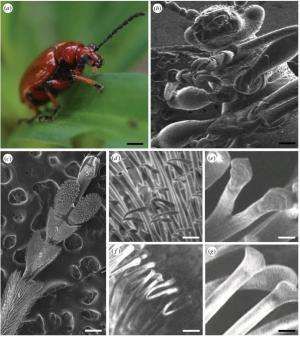January 28, 2015 report
'NanoSuit': Researchers use nano-coating to allow for electron microscopy of living insects

(Phys.org)—A team of researchers with members from several institutions in Japan has found a way to allow for using scanning electron microscopes (ESM) on living insects—encase them in a nanosuit. In their paper published in Proceedings of The Royal Society B, the team describes the coating they used and how effective it was when used on a variety of insects.
Up till now, researchers have had to kill insects and dry them before putting them under an ESM—that is because such microscopes require the specimens to be viewed in a vacuum (to keep the electron beam from scattering). In this new effort, the research team reports that they have figured out a way to apply a very thin clear coat to a specimen that prevents dehydration and thus allows specimens to be imaged as they exist naturally—representing a major step forward for research involving studying biological samples or living creatures at very close range.
The coating used by the team was an artificial material that mimics an extracellular substance, in this case, a solution consisting of surfactant polyoxyethylene sorbitan monolaurate, aka TW20, which was subjected to plasma or electron beam irradiation, causing it to polymerize. The result, they report was a very thin (50 to 100 nanometers) layer, or coating, which they immediately dubbed a nanosuit. Insects coated with the material were able to survive up to two hours in a high vacuum the team reports. In addition to preventing dehydration, the coating also prevented damage to the insects from the electron beam.
The team used the coating on several different kinds of insects and report that imaging them via ESM was done successfully and that most of the insects survived. They note that the coating remained intact (hard on the outside, soft on the inside) even if the insects moved. They also pointed out that coating the insects was easy to do—they just dipped the bugs in a solution or let a drop of it fall onto them and then wiped off the extra.
The team plans to continue testing the impact of the nanosuit on the insects that have been coated, to find out if it causes harm that is not obvious, such as damage to DNA.
More information: A 'NanoSuit' surface shield successfully protects organisms in high vacuum: observations on living organisms in an FE-SEM, Proceedings of The Royal Society B, Published 28 January 2015. DOI: 10.1098/rspb.2014.2857
Abstract
Although extremely useful for a wide range of investigations, the field emission scanning electron microscope (FE-SEM) has not allowed researchers to observe living organisms. However, we have recently reported that a simple surface modification consisting of a thin extra layer, termed 'NanoSuit', can keep organisms alive in the high vacuum (10−5 to 10−7 Pa) of the SEM. This paper further explores the protective properties of the NanoSuit surface-shield. We found that a NanoSuit formed with the optimum concentration of Tween 20 faithfully preserves the integrity of an organism's surface without interfering with SEM imaging. We also found that electrostatic charging was absent as long as the organisms were alive, even if they had not been coated with electrically conducting materials. This result suggests that living organisms possess their own electrical conductors and/or rely on certain properties of the surface to inhibit charging. The NanoSuit seems to prolong the charge-free condition and increase survival time under vacuum. These findings should encourage the development of more sophisticated observation methods for studying living organisms in an FE-SEM.
Journal information: Proceedings of the Royal Society B
© 2015 Phys.org



















